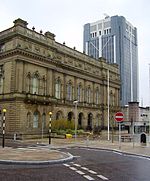Diocese of Blackburn

The diocese of Blackburn is diocese of the Church of England in North West England. Its boundaries correspond to northern Lancashire with the exception of the eastern part of the Forest of Bowland, which is part of the diocese of Leeds. The diocese contains 211 parishes and 280 churches. Blackburn Cathedral is the seat of the bishop of Blackburn, currently Philip North, and the diocesan offices are also located in Blackburn.What is now the diocese of Blackburn was historically part of the diocese of York. It became part of the newly-created diocese of Chester in 1541, and part of the diocese of Manchester when it was created in 1847. The diocese of Blackburn was in turn established on 12 November 1926 from the northern part of Manchester.
Excerpt from the Wikipedia article Diocese of Blackburn (License: CC BY-SA 3.0, Authors, Images).Diocese of Blackburn
Museum Street,
Geographical coordinates (GPS) Address Website Nearby Places Show on map
Geographical coordinates (GPS)
| Latitude | Longitude |
|---|---|
| N 53.75 ° | E -2.485 ° |
Address
The Exchange
Museum Street
BB1 7JN , Four Lane Ends
England, United Kingdom
Open on Google Maps









